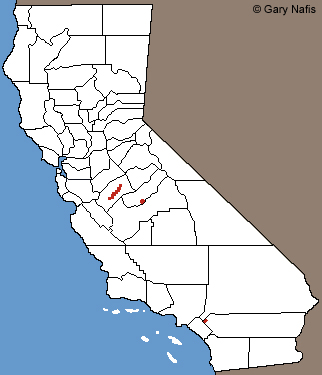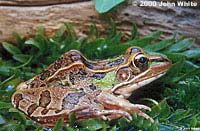|
This species has been introduced into California. It is not a native species.
|
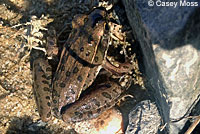 |
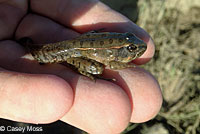 |
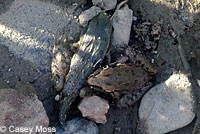 |
| Juvenile, Merced County © Casey Moss |
Tailed metamorph,
Merced County © Casey Moss |
Juvenile and tailed metamorph,
Merced County © Casey Moss |
The frogs above were formerly identified as Lithobates pipiens, but are now thought to be L. sphenocephalus.
|
| |
 |
|
| |
Merced County © Noah Morales |
|
| |
|
|
| Southern Leopard Frogs From Outside California |
 |
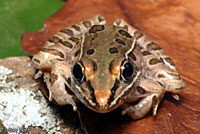 |
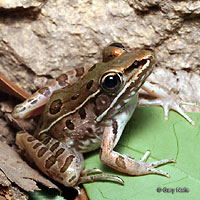 |
| |
Adult, Bastrop County, Texas |
|
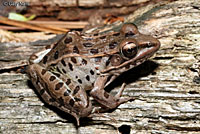 |
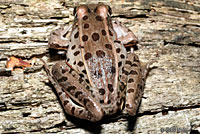 |
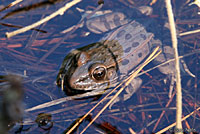 |
| Adult, Bastrop County, Texas |
Adult, Bastrop County, Texas |
 |
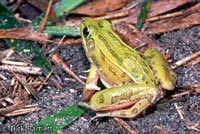 |
|
Adult, Baker County, Florida
© Dick Bartlett |
Adult, Baker County, Florida
© Dick Bartlett |
Adult, Virginia © 2000 John White |
| |
|
|
| Eggs and Tadpoles |
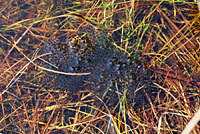 |
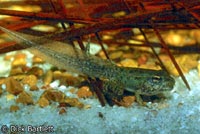 |
|
| Eggs, Bastrop County, Texas |
Transforming tadpole, Baker County, Florida © Dick Bartlett |
|
| |
|
|
| Habitat |
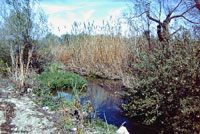 |
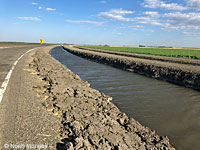 |
|
Southern Leopard Frogs have been found in this wetland in Riverside County
|
Habitat, agricultural canal, Merced County © Noah Morales |
|
| |
|
|
| Short Video |
| |
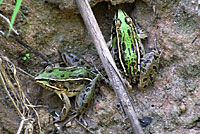 |
|
| |
Southern Leopard Frogs in Virginia. |
|
More pictures of this frog and its natural habitat are available on our Texas Herps page.
|
| Description |
| |
| Size |
Adults are 2 - 3.5 inches long from snout to vent (5.1 - 9 cm). Record 5 inches long (12.7 cm). (Conant and Collins, 1998)
|
| Appearance |
A medium-sized slender frog with a narrow head and long legs.
The tympanum has a light spot in the center.
Conspicuous dorsolateral ridges. |
| Color and Pattern |
Brown or green with rounded light-bordered dark spots on the back and sides, and striping on the legs.
There is a light upper jaw line. |
| Young |
| Young have few or no spots. |
| Larvae (Tadpoles) |
Tadpoles are brown or grey with small gold spots, creamy
below with a bronzy sheen and visible guts, and grow up to 3.5 in. in length (8.7 cm.)
|
| Life History and Behavior |
| Activity |
Mostly nocturnal.
Can be active all year long in the southern part of their native range, but they are dormant in the winter in their northern range, where they shelter in permanent bodies of water that do not freeze completely and that contain plenty of oxygen.
Frogs move away from water in summer, after breeding, using vegetation for shelter and shade, but in dry periods they stay in moist areas near springs, lakes, rivers and creeks.
|
| Defense |
| To avoid predation, frogs dive into water, turning sharply underwater, before coming up in vegetation. Often when approached as they rest at the edge of a water source, they will escape inland. On land they leap quickly, with each leap in a different direction. |
Territoriality
|
| Not understood but unlikely. |
| Longevity |
| Not known. |
| Voice (Listen) |
A moderately loud short guttural trill.
Males make their advertisement call while floating on open water, from vegetation, or while sitting on logs or sticks.
Males call at night and occasionally during the day, using paired vocal sacs found between the jaw and shoulders. |
| Diet and Feeding |
| Eats a wide variety of invertebrates, including crayfish. |
| Reproduction |
Reproduction is aquatic.
Fertilization is external, with the male grasping the back of the female and releasing sperm as the female lays her eggs.
The reproductive cycle is similar to that of most North American Frogs and Toads. Mature adults come into breeding condition and move to ponds or ditches where the males call to advertise their fitness to competing males and to females. Males and females pair up in amplexus in the water where the female lays her eggs as the male fertilizes them externally. The adults leave the water and the eggs hatch into tadpoles which feed in the water and eventually grow four legs, lose their tails and emerge onto land where they disperse into the surrounding territory.
In the native range of this frog, mating and egg-laying occurs from early Spring in the northern part of the range and in any month in the southern part of the range.
|
| Eggs |
Eggs are laid in still shallow water, usually attached to vegetation. Communal nesting has been documented.
Females lay 1,200 to 1,500 eggs, possibly as many as 5,000.
Eggs have been observed hatching in 4 - 5 days in Florida and in less than 2 weeks in Missouri. |
| Tadpoles and Young |
Tadpoles metamorphose in 50 - 75 days.
This can be April to October across their native range.
|
| Habitat |
Inhabits many types of shallow, freshwater habitats, including temporary pools, and permanent waters such as ponds, lakes, irrigation canals, ditches and the edges of streams and rivers.
|
| Range |
Native Range
L. sphenocephalus occurs along the east coast of North America from Long Island to Florida, west through Virginia, Kentucky, Tennessee, Arkansas, Georgia, Alabama, Mississippi, Louisiana, Arkansas, Illinois, Missouri and barely into Iowa, and the eastern parts of Nebraska, Oklahoma, and Texas. (See map below.)
Introductions in California
In the early-1990s Michael Fuller discovered an introduced population of Southern leopard frogs in western Riverside Co, near the border of Orange Co. upstream of Prado Dam. The subspecies was not determined. These Frogs, previously recorded as Rana pipiens, were most likely first introduced at the Chino Gun Club in 1929 or 1930, probably as larvae that arrived with other imported Bullfrogs, fish, and crayfish from Louisiana. They spread throughout the Santa Ana river basin in eastern Orange and western Riverside counties, including locations from the Anaheim Hills, to Corona and the southwest corner of Irvine Lake. They are now common in the Prado Flood Control Basin, in areas that are becoming urbanized, sharing their habitat with other introduced amphibians - Bullfrogs and African Clawed Frogs. (Jennings and Fuller, 2004)
In March, 2016, two female Southern Leopard Frogs were found in Madera County at the San Joaquin River just northwest of Fresno on the border with Fresno County. They represent a presumed second established population of the species in California. (Shaun T. Root Herpetological Review 48(2), 2017)
In May 2021 I received unpublished information that frogs formerly identified as L. pipiens in Merced County were determined to be L. sphenocephalus. Leopard frogs were introduced to the area decades ago when several species, including L. sphenocephalus, were all recognized as L. pipiens. Difficulties in differentiating species of leopard frogs have likely caused misidentifications. The species appears to occur from Atwater to Los Banos, at least, in Merced County.
|
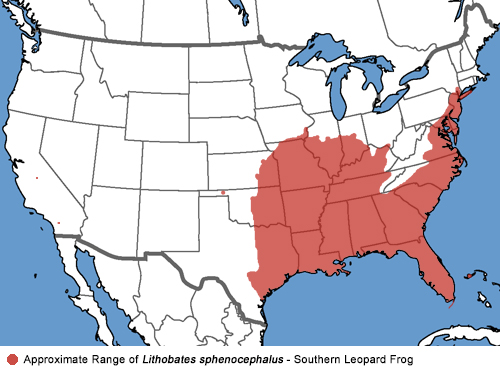 |
| Notes on Taxonomy |
In 2006, Frost et al divided North American frogs of the family Ranidae into two genera, Lithobates and Rana. Rana is still used in most existing references.
Two subspecies are recognized:
Lithobates sphenocephala sphenocephala (Rana sphenocephalus sphenocephalus) - Florida Leopard Frog
and Lithobates sphenocephala utricularia (Rana sphenocephalus utricularius ) - Southern Leopard Frog
Frogs introduced into California are thought to be L. s. utricularia, but this is not certain.
Alternate and Previous Names (Synonyms)
Rana utricularia - Southern Leopard Frog (Conant & Collins 1998)
Rana pipiens sphenocephala - Southern Meadow Frog (Southern Leopard Frog, Spring Frog, Spotted Frog, Water Frog, Shad Frog) (Wright and Wright 1949)
Rana pipiens - Leopard Frog (Storer 1925)
Rana pipiens (Schreber 1782)
|
| Conservation Issues (Conservation Status) |
None known in their native range where they are ubiquitous and abundant in many areas.
In California, as is the case with any introduced species, they could cause problems for established native animals by outcompeting with them for resources, or by eating them or their young. |
|
| Taxonomy |
| Family |
Ranidae |
True Frogs |
Rafinesque, 1814 |
| Genus |
Lithobates |
American Water Frogs |
Fitzinger, 1843 |
Species
|
sphenocephala |
Southern Leopard Frog |
Cope, 1886 |
|
Original Description |
Rana sphenocephala - Cope, 1886 - Proc. Amer. Philos. Soc., Vol. 23, p. 517
from Original Description Citations for the Reptiles and Amphibians of North America © Ellin Beltz
|
|
Meaning of the Scientific Name |
Lithobates - Greek - Litho = a stone, bates = one that walks or haunts
sphenocephala - Greek = wedge-headed
Taken in part from Scientific and Common Names of the Reptiles and Amphibians of North America - Explained © Ellin Beltz
|
|
Related or Similar California Frogs |
Lithobates berlandieri
Lithobates pipiens
Lithobates catesbeianus
Lithobates yavapaiensis
Rana draytonii
Rana aurora
Rana boylii
Rana cascadae
Rana pretiosa
Rana muscosa
|
|
More Information and References |
California Department of Fish and Wildlife
AmphibiaWeb
Jennings, Mark R., and Michael M. Fuller. 2004. Origin and distribution of leopard frogs, Rana pipiens complex, in California. California Fish and Game 90(3):119-139.
Hansen, Robert W. and Shedd, Jackson D. California Amphibians and Reptiles. (Princeton Field Guides.) Princeton University Press, 2025.
Stebbins, Robert C., and McGinnis, Samuel M. Field Guide to Amphibians and Reptiles of California: Revised Edition (California Natural History Guides) University of California Press, 2012.
Stebbins, Robert C. California Amphibians and Reptiles. The University of California Press, 1972.
Flaxington, William C. Amphibians and Reptiles of California: Field Observations, Distribution, and Natural History. Fieldnotes Press, Anaheim, California, 2021.
Nicholson, K. E. (ed.). 2025. Scientific and Standard English Names of Amphibians and Reptiles of North America North of Mexico, with Comments Regarding Confidence in Our Understanding. Ninth Edition. Society for the Study of Amphibians and Reptiles. [SSAR] 87pp.
Robert Powell, Roger Conant, and Joseph T. Collins. Peterson Field Guide to Reptiles and Amphibians of Eastern and Central North America. Fourth Edition. Houghton Mifflin Harcourt, 2016.
Conant, Roger, and Joseph T. Collins. A Field Guide to Reptiles and Amphibians Eastern and Central North America.
Third Edition, Houghton Mifflin Company, 1998.
American Museum of Natural History - Amphibian Species of the World 6.2
Bartlett, R. D. & Patricia P. Bartlett. Guide and Reference to the Amphibians of Western North America (North of Mexico) and Hawaii. University Press of Florida, 2009.
Elliott, Lang, Carl Gerhardt, and Carlos Davidson. Frogs and Toads of North America, a Comprehensive Guide to their Identification, Behavior, and Calls. Houghton Mifflin Harcourt, 2009.
Lannoo, Michael (Editor). Amphibian Declines: The Conservation Status of United States Species. University of California Press, June 2005.
Storer, Tracy I. A Synopsis of the Amphibia of California. University of California Press Berkeley, California 1925.
Wright, Albert Hazen and Anna Wright. Handbook of Frogs and Toads of the United States and Canada. Cornell University Press, 1949.
Behler, John L., & F. Wayne King. The Audubon Society Field Guide to North American Reptiles and Amphibians. Alfred A. Knopf, 1992.
|
|
|
The following conservation status listings for this animal are taken from the July 2025 State of California Special Animals List and the July 2025 Federally Listed Endangered and Threatened Animals of California list (unless indicated otherwise below.) Both lists are produced by multiple agencies every year, and sometimes more than once per year, so the conservation status listing information found below might not be from the most recent lists, but they don't change a great deal from year to year.. To make sure you are seeing the most recent listings, go to this California Department of Fish and Wildlife web page where you can search for and download both lists:
https://www.wildlife.ca.gov/Data/CNDDB/Plants-and-Animals.
A detailed explanation of the meaning of the status listing symbols can be found at the beginning of the two lists. For quick reference, I have included them on my Special Status Information page.
If no status is listed here, the animal is not included on either list. This most likely indicates that there are no serious conservation concerns for the animal. To find out more about an animal's status you can also go to the NatureServe and IUCN websites to check their rankings.
Check the current California Department of Fish and Wildlife sport fishing regulations to find out if this animal can be legally pursued and handled or collected with possession of a current fishing license. You can also look at the summary of the sport fishing regulations as they apply only to reptiles and amphibians that has been made for this website.
This frog is not included on the Special Animals List, meaning there are no significant conservation concerns for it in California according to the California Department of Fish and Game.
|
| Organization |
Status Listing |
Notes |
| NatureServe Global Ranking |
|
|
| NatureServe State Ranking |
|
|
| U.S. Endangered Species Act (ESA) |
|
|
| California Endangered Species Act (CESA) |
|
|
| California Department of Fish and Wildlife |
|
|
| Bureau of Land Management |
|
|
| USDA Forest Service |
|
|
| IUCN |
|
|
|
|
|
